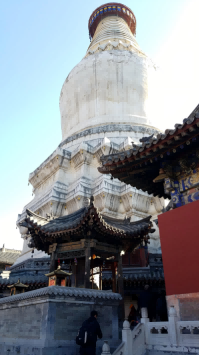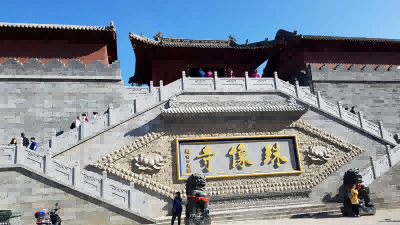It is overland tour to Mt. Wudangshan in Hubei province from Xian. Hubei province is located in mid China connecting many provinces in China by convenient transportation of railway, cruise, and flights......

Wutaishan Mountain, located in Xinzhou City, Shanxi Province,  is the first of the four famous Buddhist sacred mountains in China. The five peaks of Wutaishan mountain are as flat as a platform in their top, so they are named five platforms. Because the mountain climate is cold, summer is still not hot summer, so it is also called Qingliangshan, means cool mountain. The scenic area covers an area of 607 square kilometers.
is the first of the four famous Buddhist sacred mountains in China. The five peaks of Wutaishan mountain are as flat as a platform in their top, so they are named five platforms. Because the mountain climate is cold, summer is still not hot summer, so it is also called Qingliangshan, means cool mountain. The scenic area covers an area of 607 square kilometers.
Wutaishan mountain is a Buddhist monastery mixed both the green temples and yellow temples coexisted in harmony. There are still 86 temples for religious activities, many of which were built and visited by the emperors in the past. Now the most famous 5 temples are the Shuxiang Temple, Xiantong Temple, Tayuan Pagoda Temple, Pushading (Bodhisattva top ) and Dailuoding.
Buddhism was introduced to Wutaishan mountain during the Eastern Han Dynasty, 2,000 years ago. In 68 AD, two Indian monks of JiayMoten and Zhu Falan came to Mount Wutai. Since there was an early occurrence of King Ashoka's relic pagoda in the mountains, and Mount Wutaishan is the place where Manjusri Bodhisattva acted and lived, so the two men built a temple here. In the 4th and 5th centuries, during the Southern and Northern Dynasties, the development of Buddhism in Mount Wutaishan showed its first climax, and the temples of Mount Wutai soared to more than 200. In the Tang Dynasty from the 10th to the 11th century, the development of Buddhism on Mount Wutaishan had a second climax. There were as many as 300 temples in the whole mountain and more than 10,000 monks. In the Tang Dynasty, Buddhism was highly respected, and Manjusri Bodhisattva was especially respected by Buddhists. According to the state regulations, all monasteries in the country must worship the sacred statues of Manjusri Bodhisattva. Therefore, Mount Wutaishan was respected called the holy homeland of Manjusri Bodhisattva. Mount Wutaishan is also admired by Buddhists in India, Japan, North Korea and Sri Lanka.
There are still 86 temples with relatively complete buildings in Mount Wutaishan. According to the different inheritance of Buddhism, the temples are divided into Green Temples and Yellow Temples. Green temple is also known as the temple of monks, they are mostly the Chinese Han people, and generally wear in gray. Most of the temples on Mount Wutaishan belong to Green Temples.
The Yellow Temple, also known as the Lama Temple, belongs to Tibetan Buddhism. All the Tibetan Buddhism in Mount Wutaishan belongs to the Gelupa School founded by Master Tongkaba. Monks of Lama temple all wear yellow clothes and yellow hats, therefore they are called yellow monks. There are 12 yellow temples in Mount Wutaishan, namely, Pushading Bodhisattva Top, Rahul Temple, Guangren Temple, Ten Thousand Buddha Pavilion, Zhenhai Temple, Guanghua Temple, Guanyin Cave, Shangshancai Cave, Tiancheng Temple, Tailu Temple, Manjusri Temple and Ruiying Temple.
Introduction to the famous temples in Wutaishan Mountain:
Tayuan temple / Pagoda courtyard Temple
Tayuan temple, means Pagoda courtyard temple, is located in the center of Taihuai Town, Mount Wutaishan. Tayuan temple is named after the Great White Pagoda, which is the symbol of Mount Wutaishan. The great white pagoda is 75.3 meters high and surrounded by 83 meters. It was first built during the reign of Emperor Xiaowen of the Northern Wei Dynasty in 5th century. It is recorded that there was a stupa built by King Ashoka in the Great White Pagoda, so Buddhists had to first worship this sacred site in Mount Wutaishan. There is also a Manjusri pagoda in the temple, where it is said to stored the hair of Manjusri.
Xiantong temple
Xiantong Temple is located after Mount Wutaishan Tayuan Temple. The existing buildings are built in the Ming and Qing dynasties. The temple covers an area of more than 80,000 square meters and more than 400 buildings. The infinite hall is 21 meters high, without a single beam wood, all made of bricks, the outer eaves brick carved bucket arch flowers, the inner carved algae well suspended, shaped like a flower cover treasure top, a strange construction. Copper hall three square, up to five meters high, outside the carved flowers and figures, birds and animals.
Shuxiang temple
Shuxiang temple is located 1 km southwest of Taihuai town in Wutaishan Mountain. Its most famous building is the Wenshu Bodhisattva Pavilion (main hall), which is the largest hall in the Mount Wutaishan. In the middle of the temple, the statue of the Bodhisattva riding lion is nearly ten meters high, which is the largest manjusri statue in the temples of Mount Wutaishan. On the three walls of the Manjusri Hall, there are five hundred arhat figures. The whole hall is decorated more colorful due to the contrast of colors.
Pushading Temple / Bodhisattva top
Pushading temple, means Bodhisattva top, is located on the peak of Lingjiufeng of Wutaishan. Pushading is the largest yellow scholl temple on Mount Wutaishan. The temple is magnificent and colorful in building, which is the royal palace in the past dynasties when they visited Mount Wutaishan. The temple was founded between 471 AD and 499 AD. Many believers of Mongolian and Tibetan Buddhism entered Mount Wutaishan, and it became the first of the yellow Temple of Mount Wutaishan. Emperor Kangxi and Emperor Qianlong of the Qing Dynasty also visited Mount Wutai several times and stayed in Pushading temple, who gave the temle of the seal of Bodhisattva, and ordered the governor of Shanxi Province to pay tribute to the big Lama in Pushading.
Dailuoding Temple
Dailuoding is a small mountain peak actually extending down from the east top of Mount Wutaishan with a vertical height of only 400 meters. To reach the top of Dailuoding, you need to walk on 1080 steps, called Dazhi Big Wisdom Road, all paved with blue stone of Wutaishan. It is said when you boarded the Dazhi Road, your troubles was relieved. After reaching the top, you saw the archway, the stone lion and the mountain gate of the snail. The temple building is beautiful and elegant, and the layout is rigorous and neat.
NanChan temple
Nanchan temple in Wutaishan has a special significance in the history of Chinese Buddhism. Emperor Wuzong of the Tang Dynasty destroyed the Buddha, and only the Nanshan Temple escaped the disaster, fortunately stored alone in Mount Wutaishan, and thus became the oldest existing wooden building. This ancient temple is small and exquisite, among which the Great hall, more than 1,200 years ago, preserved the typical Tang Dynasty architectural style.
Foguang Temple
Located on the mountainside of Mount Wutaishan and Foguang Mountain, it has the reputation of "Buddha Light of Asia". The temple is built on the mountain, surrounded by the east, south and north three peaks, with a large scale. Its buildings, statues, murals and ink are known as the "four wonders". Foguang Temple is an existing example of wooden architecture in the Tang Dynasty, and has a prominent position in the history of architecture. In the East University Temple, there are 35 painted clay Buddha statues of the Tang Dynasty, which are plump and lifelike. Most of the murals are original works from the Tang Dynasty, but also from the Song and Ming Dynasties, which are rare works of art.
Longquan Temple
Longquan Temple is located in Mount Wutaishan surrounded by Kowloon hills, three courtyards are arranged horizontally, and become a distinctive pattern. There is a pair of white marble stone lions in front of the mountain. The most eye-catching is the white marble archway, known as a unique Longquan Temple. From the cornerstone to the tile top, are carefully carved.
Tour Map of Wutai shan Mountain:

Weather Information of Wutai shan Mountain:

Note: From January to December, red line is the highest Centigrade in average, blue line is the lowest climate in average.

It is overland tour to Mt. Wudangshan in Hubei province from Xian. Hubei province is located in mid China connecting many provinces in China by convenient transportation of railway, cruise, and flights......

One day classic tours of Chengdu to Mt. Qingchengshan and Dujiangyan Dam will show tourist the profound of ancient Chinese wisdom and culture in harmony relation with the world. ......

The most classic one day Chengdu tours will bring tourist to Chengdu Giant panda garden and Leshan giant buddha with private travel guide and car in Chengdu, extremely convenient and easy!......

One days best Chengdu tours bring tourist to Sanxingdui museum and giant panda garden with private guide and car, making your tour in Chengdu easy. ......
This panda volunteer work provide tourist with one days unique experience of Panda volunteer project works and bring them an intimate touch with Giant pandas, also the best way to learn deep about pand......

It is tour from the only one operator in Chengdu tours market offering Emeishan and Leshan tours by bullet train. Our highlights including Leshan Giant Buddha and Mt Emeishan. ......

